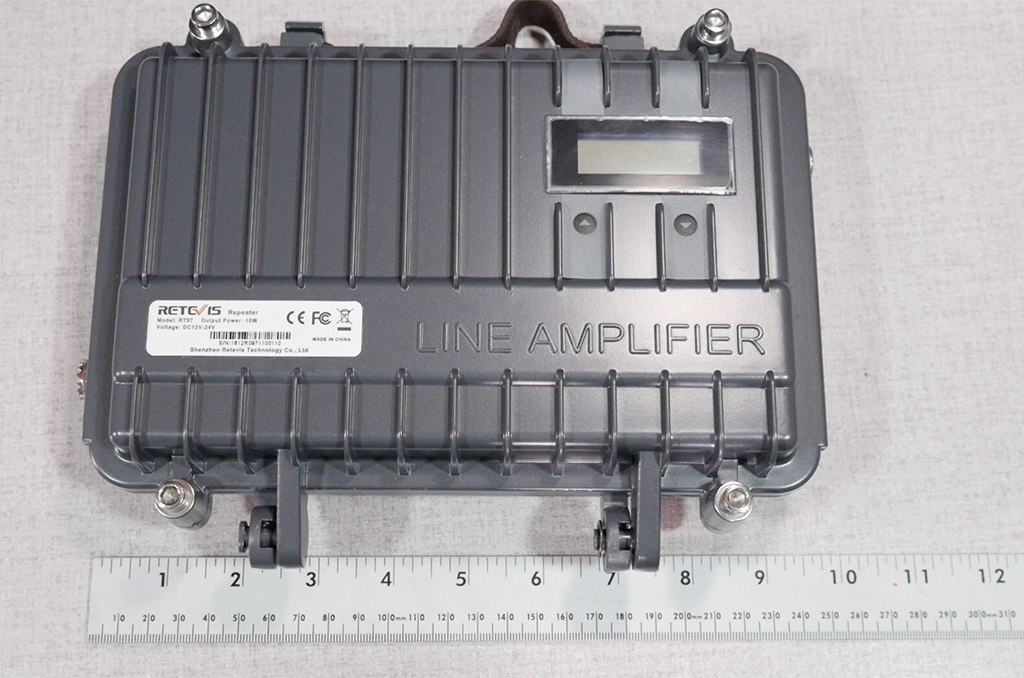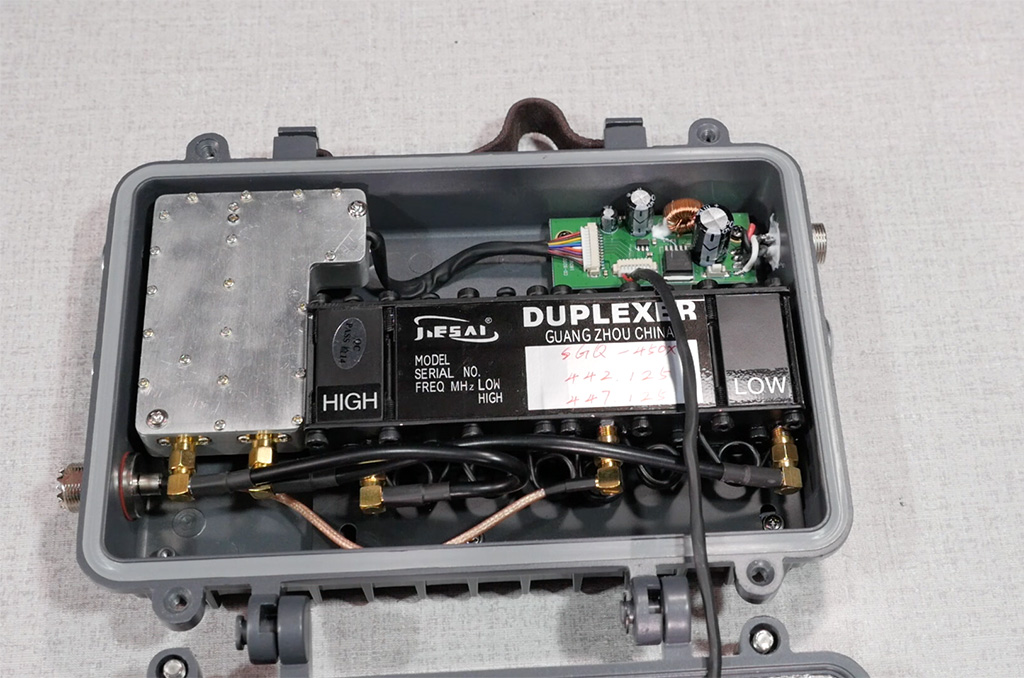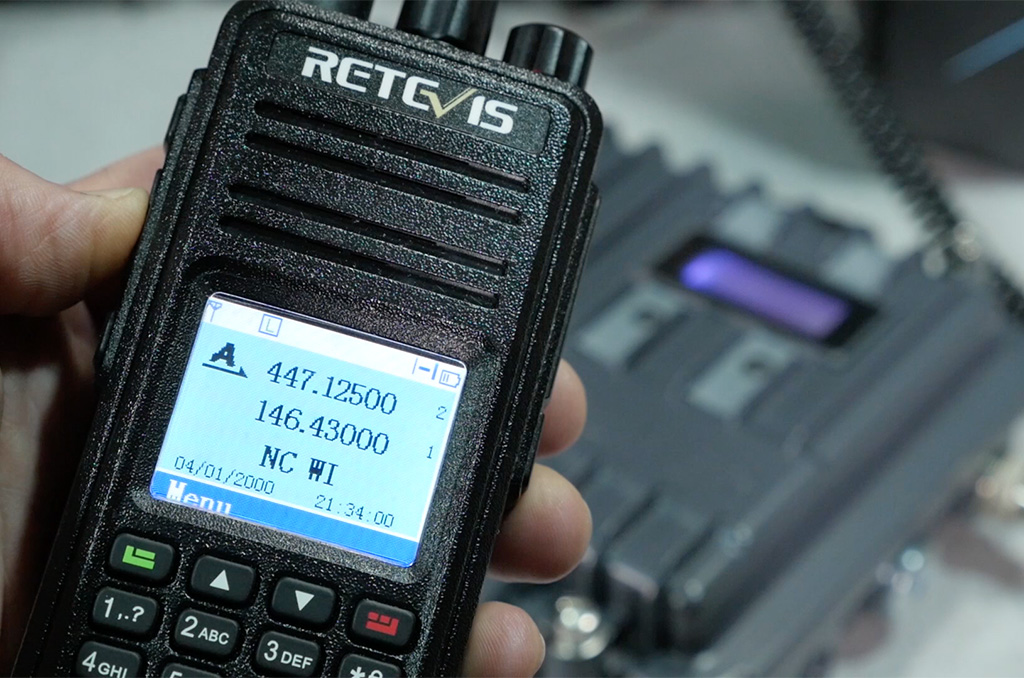Well, the mystery box has been opened and the contents revealed. Today we’re going to take a look at the Retevis RT97 portable repeater. In fact, I’ll be doing a couple of videos on the RT97. This first one is an overview of the RT97, with a look at its features and specifications, a peek inside, and pros and cons. Be sure to watch til the end, because I’ll also talk about if this repeater is legal to use in the US. Following that, I’ll do another video where I set it up and demonstrate its use. With that said, let’s dig in.
Opening up the box, the RT97 portable repeater comes with an AC adapter and power cord, 12 volt DC power cable, and a USB programming cable. Then repeater itself is housed in a heavy duty aluminum enclosure. On one side is the four pin power port and the other side is an UHF female connection. There’s what appears to be a leather carrying strap on the top and a small LCD display and two buttons on the front of the unit. There is no power switch, the unit turns on when power is applied to it.
 Taking a quick look at the specs, the RT97 portable repeater is available as either a VHF or UHF unit and can be ordered with either a 5 MHz or 10 MHz offset split. We’ll talk more about that in a bit. This is an FM analog repeater, has 16 memory channels, 10 watts output power, wide or narrow band operation, CTCSS and DCS tone squelch, and 12-24 volt operation. Dimensions are 9.5 x 7.5 inches and 3 inches thick. The enclosure is marked ‘line amplifier’ so I believe it is a repurposed a cable network line amplifier for the repeater. I find that pretty inventive and it gives you an idea of the relatively small size the entire package, but it does have a tradeoff.
Taking a quick look at the specs, the RT97 portable repeater is available as either a VHF or UHF unit and can be ordered with either a 5 MHz or 10 MHz offset split. We’ll talk more about that in a bit. This is an FM analog repeater, has 16 memory channels, 10 watts output power, wide or narrow band operation, CTCSS and DCS tone squelch, and 12-24 volt operation. Dimensions are 9.5 x 7.5 inches and 3 inches thick. The enclosure is marked ‘line amplifier’ so I believe it is a repurposed a cable network line amplifier for the repeater. I find that pretty inventive and it gives you an idea of the relatively small size the entire package, but it does have a tradeoff.
When you order the unit, it will be customized according to your frequency choice. The reason for that is that the duplexer needs to be tuned to your frequencies. Because of the small size, the duplexer is quite small, hence the 5 or 10 mhz frequency split choice. The duplexer consists of six cavities that provide about 80db of filtering and isolation with only 1db of insertion loss. This is necessary so that the unit can simultaneously receive and transmit on one antenna. As your receive and transmit frequencies get closer together, the cavities need to be larger to provide the same level of isolation. Plus as you go lower in frequency, the cavities will also get bigger. But if you keep the split at 5 mhz or more, you an overcome those physical limitations. But that also rules out using this unit on the VHF amateur radio band as the split would be wider than the entire frequency allocation.
 Looking around inside the repeater, not only do you see the duplexer that we talked about, but also the radio units, one for receive and another for transmit, encased in an aluminum block and a circuit board that appears to provide power filtering and programming control.
Looking around inside the repeater, not only do you see the duplexer that we talked about, but also the radio units, one for receive and another for transmit, encased in an aluminum block and a circuit board that appears to provide power filtering and programming control.
I think the winning feature of the Retevis RT97 is its ease of setup and use. After I unpacked the unit I plugged it in, applying the power. The unit had the frequency pair I specified during ordering set up as channel one. The default CTCSS code was 136.5 and I could examine that by long pressing the channel select button. frequencies and tones can be changed with the programming software, but if you change the frequency, the duplexers will also need to be retuned- a process that requires special equipment.
 I hooked the unit to an outside antenna and programmed the channel into a handheld radio, and I was ready to go. I want to mention something about the frequency pairs. Normally in the US, a UHF repeater will receive on the upper frequency and transmit on the lower one. With the RT97, this is reversed- it listens on the lower frequency and transmits on the upper one. I don’t know if that limitation has something to do with how the duplexer is set up or what- I’ll have to investigate why. But there is nothing against the rules or FCC regulations about that- so you will just need to be aware that the transmit and receive frequency pair is swapped.
I hooked the unit to an outside antenna and programmed the channel into a handheld radio, and I was ready to go. I want to mention something about the frequency pairs. Normally in the US, a UHF repeater will receive on the upper frequency and transmit on the lower one. With the RT97, this is reversed- it listens on the lower frequency and transmits on the upper one. I don’t know if that limitation has something to do with how the duplexer is set up or what- I’ll have to investigate why. But there is nothing against the rules or FCC regulations about that- so you will just need to be aware that the transmit and receive frequency pair is swapped.
I’ll demonstrate the use of RT97 along with some range testing in an upcoming video. But let’s look at the pros and cons of the Retevis RT97 portable repeater.
The good things that I like about the RT97 are
- Compact size
- Easy setup
- Weather resistant design
- AC Adapter and DC power plug
- 10 watts power
The downside of the RT97 are these:
- Only the 5Mhz split UHF model can be used in the US
- Lack of repeater controller:
- No repeater ID function
- No timeout timer
- Transmit / Receive frequencies reversed
Bottom line, the RT97 is an all in one solution that gives you a portable repeater in a rugged, small package. I see quite a bit utility of this unit for event communications, emergency communication groups, outdoor enthusiasts, and neighborhood groups.
Regulatory issues
The big question I’m going to receive in the comments: is this unit legal to operate in the US. The short answer is: yes, on the amateur radio bands. The RT97 does not have any part 90 or part 95 certification that I can find, so it can’t legally be used on the land mobile or GMRS bands, although it potentially would make an excellent GMRS repeater.
On the amateur bands, there are two issues that are potential sticking points for this repeater. First is repeater control, and the second is identification.
Amateur radio repeaters are devices that fall under the FCC regulation, specifically Part 97.205. Paragraph (d) allows a repeater to function under automatic control. A control operator doesn’t need to be at the control point to operate the device, it functions automatically. But a control operator does need to have a method to gain control of the repeater if it malfunctions. And to that point, many repeaters will use remote control as defined in 97.213 which would be an auxiliary link or phone line to control the repeater. A remote controlled repeater can also function automatically, but also needs extra facilities to ensure the control link doesn’t malfunction. So the FCC requires remotely controlled stations to Have a three minute timeout timer.
Since this repeater is fully on automatic control with no remote control links, the timeout timer isn’t a necessity. In case of malfunction, the best that you can do is to disconnect the power. That means that an individual would need ready access to the box to disconnect the power if it malfunctioned. So the RT97 may not be a good choice as a repeater located at a remote permanent site, but would be fine for temporary use in an area where easy access is available.
The second item is repeater identification. In Part 97.119 each amateur station must transmit its assigned callsign on its transmitting channel at the end of each communication and at least at 10 minute intervals. Repeaters traditionally have functions built in the controller to identify, either by voice or morse code, the callsign of the repeater every ten minutes when the repeater is active. This callsign is of the control operator or owner of the repeater, be it a club or an individual. Since there isn’t a built in identifier in the RT97, it will be up to the user to identify the repeater. So if you are in a conversation on it, you will at 10 minute intervals need to say your callsign and the repeater callsign: such as KB9VBR on the KB9VBR repeater. An extra step, but one that keeps you on the right side of the rules.
I’m sure I’ll get comments on this, so please let me know were my interpretation of the rules is wrong.
That’s my first look of the Retevis RT97 portable repeater. If you have any questions or comments, please leave them in the comments below. I’ll have a followup video soon with a demonstration of the repeater, and I should be able to address some of your questions in that video. Otherwise I’ll save them for my next Your Questions Answered video.
Recent Comments